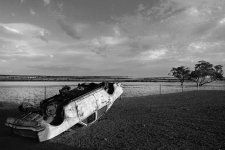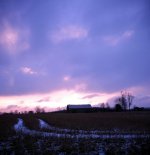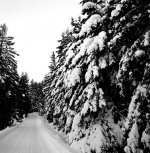jaffa_777
Established
Well I finally did it! I got my Mamiya 6, and Nikon scanner. For those who would like to know, I was a digital guy and enquired on this forum a while ago about this film mystery. Went to the country and shot some film a few weeks ago. Spent all today working out how to use my scanner. It is a huge learning curve. Many times I felt like throwing everything back on ebay and forgotting about it. But I am still plugging away. I haven't perfected the art of scanning yet, but have just been blown away by this image. While the low res web image doesn't represent the beautifull scan, I think when compared against the digital one from my d200, you will see the difference, there is no comparison!
Black and white film seems very hard to scan though. I have been trying to scan hp5 and the results at the moment are quite average. Is it better to scan black and white for web only and do your prints/enlargemnets the traditional way?


Black and white film seems very hard to scan though. I have been trying to scan hp5 and the results at the moment are quite average. Is it better to scan black and white for web only and do your prints/enlargemnets the traditional way?


jaffa_777
Established
The top image is from the Mamiya 6, shot on E100g. The bottom image is from the d200 in Vivid setting.
Abbazz
6x9 and be there!
Congrats Jaffa on your new acquisition. Your pictures are superb. I think you are doing great with the scanner: I love the colors and tonal range you managed to achieve.
If you want to shoot BW negatives that scan easily, try Ilford XP2 Super or any other chromogenic BW film. It's convenient because one can have it processed anywhere in the world and the negatives scan like butta.
Cheers,
Abbazz
If you want to shoot BW negatives that scan easily, try Ilford XP2 Super or any other chromogenic BW film. It's convenient because one can have it processed anywhere in the world and the negatives scan like butta.
Cheers,
Abbazz
jaffa_777
Established
Thanks Abbazz.
I understand now when people say scanning is a tedious process. I full quality high res scan of 120 6x6 takes about an hour.
I have shot some xp2 super but was less than impressed with the results on the contact sheet and scans. I took them to a pro lab too. They are very washed in grey, and lack tonal range and contrast, but are finer grain. The black and white film I had developed look vastly superior on contact sheets, but when scanned seem to lack resolution and have lots of grain. I may ask this question in the film forum I think. I heard tri-x scans better than hp5?
One more from the Mamiya 6 too. I am just loving film, oh the colour!

I understand now when people say scanning is a tedious process. I full quality high res scan of 120 6x6 takes about an hour.
I have shot some xp2 super but was less than impressed with the results on the contact sheet and scans. I took them to a pro lab too. They are very washed in grey, and lack tonal range and contrast, but are finer grain. The black and white film I had developed look vastly superior on contact sheets, but when scanned seem to lack resolution and have lots of grain. I may ask this question in the film forum I think. I heard tri-x scans better than hp5?
One more from the Mamiya 6 too. I am just loving film, oh the colour!

The sunset windmill shot is really nice, Andrew! That the blades and tail are blurred from movement really ads a "here and now" feel. Congratulations on the new MF RF cam, and I expect you'll love it. 
jan normandale
Film is the other way
Try scanning the bw in colour then 'removing the colour' in PS it may help.
Here are two images from a Mamiya 6 first is a colour shot, the second is a C41 BW from Kodak. It scans well. Also large scans... take large amounts of time. Scan smaller unless you intend to go to a print.
Here are two images from a Mamiya 6 first is a colour shot, the second is a C41 BW from Kodak. It scans well. Also large scans... take large amounts of time. Scan smaller unless you intend to go to a print.
Attachments
Last edited:
Abbazz
6x9 and be there!
jaffa_777 said:I have shot some xp2 super but was less than impressed with the results on the contact sheet and scans. I took them to a pro lab too. They are very washed in grey, and lack tonal range and contrast, but are finer grain. The black and white film I had developed look vastly superior on contact sheets, but when scanned seem to lack resolution and have lots of grain. I may ask this question in the film forum I think. I heard tri-x scans better than hp5?[/IMG]
Another great picture!
If you are after fine grain and good tonal range and you want to use traditional BW film, try the Efke/Adox 25. It works great for me and scans easily.
But maybe the easiest path, as you seem to master color scanning, is to shoot in color and convert to BW in Photoshop afterwards:

Cheers,
Abbazz
Jamie123
Mentor
What software are you using to scan the negs? Personally, I think Silverfast is the best scanning software out there but it's quite expensive (I only have the SE version of it). Others seem to like Vuescan.
jaffa_777
Established
I would love to be able to shoot a 25 speed film, but sadly most of my work isn't landscape on a tripod. Handheld documentary is what I love and mostly do. And the Mamiya lenses aren't that fast. So 400 film is a good general handheld speed for this camera. I could get away with 100 in overcast conditions in the middle of the day maybe. I will try some different scanning methods on my hp5 and xp2 negs from my shearing series and post a few soon.
jaffa_777
Established
Hi Jamie, I am using Vuescan at the moment. It seems to handle my kodak chromes supurbly. I have silverfast studio AI which came the scanner but there is a problem unlocking it with the serial key. I have written to Lasersoft a few days ago but they haven't got back to me yet. I can't wait to try it.
Nachkebia
Well-known
Yes yes yes!
P C Headland
Well-known
Some lovely shots there - definitely getting the hang of that film thingy 
If you tire of the Nikon scanner, send it down here, I'll look after it for you!
For ISO400 film, so far I've found the easiest to scan are Fuji Neopan 400 and TriX 400 developed in Diafine. I shoot the Neopan at 650, and TriX at 1000.
I'm just getting into PC-TEA, a homebrew developer, and have to say it makes scanning easy too. Even some 35mm Rollei Retro 400 (rebranded Agfa APX400) scanned well with very little grain.
Sometimes, maybe just every now and then, you should fill the camera with some Efke 25 or maybe Delta 100 and see that camera really shine.
If you tire of the Nikon scanner, send it down here, I'll look after it for you!
For ISO400 film, so far I've found the easiest to scan are Fuji Neopan 400 and TriX 400 developed in Diafine. I shoot the Neopan at 650, and TriX at 1000.
I'm just getting into PC-TEA, a homebrew developer, and have to say it makes scanning easy too. Even some 35mm Rollei Retro 400 (rebranded Agfa APX400) scanned well with very little grain.
Sometimes, maybe just every now and then, you should fill the camera with some Efke 25 or maybe Delta 100 and see that camera really shine.
jaffa_777
Established
Ok, just made my first succsesful scan of HP5+. I tried my locked demo version of silverfast, and it definately deals with black and white negs better than vuescan. I roughly cloned out the watermarks.


jaffa_777
Established
I love the grain and tonality of this film!
Nachkebia
Well-known
silverfast for black and white? hmmmm
BronicaLee
Established
Yes, very nice indeed. Chalk up another convert!
dragonx
Member
great thread and great shots.
Share:
-
This site uses cookies to help personalise content, tailor your experience and to keep you logged in if you register.
By continuing to use this site, you are consenting to our use of cookies.



